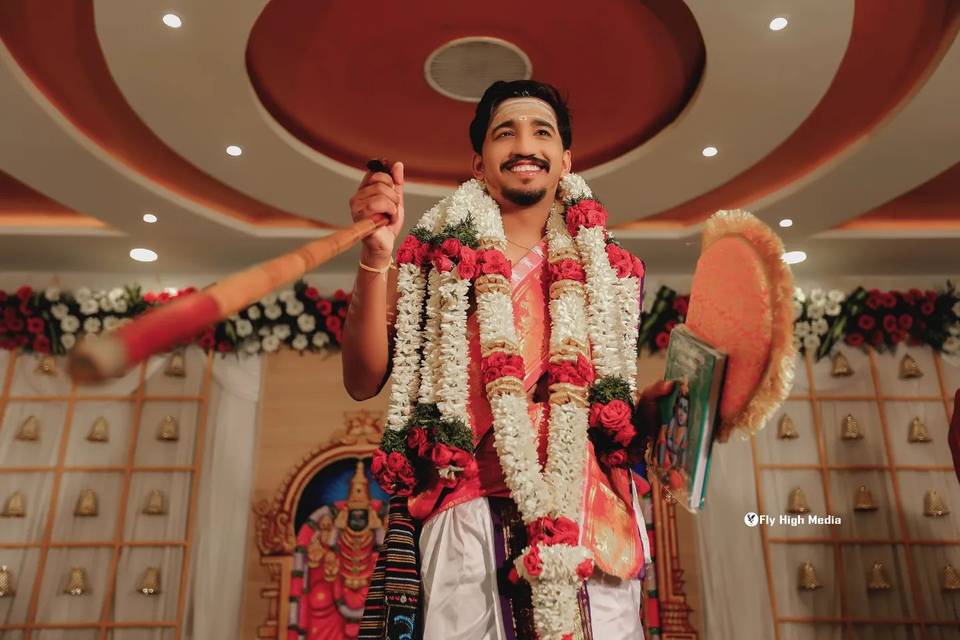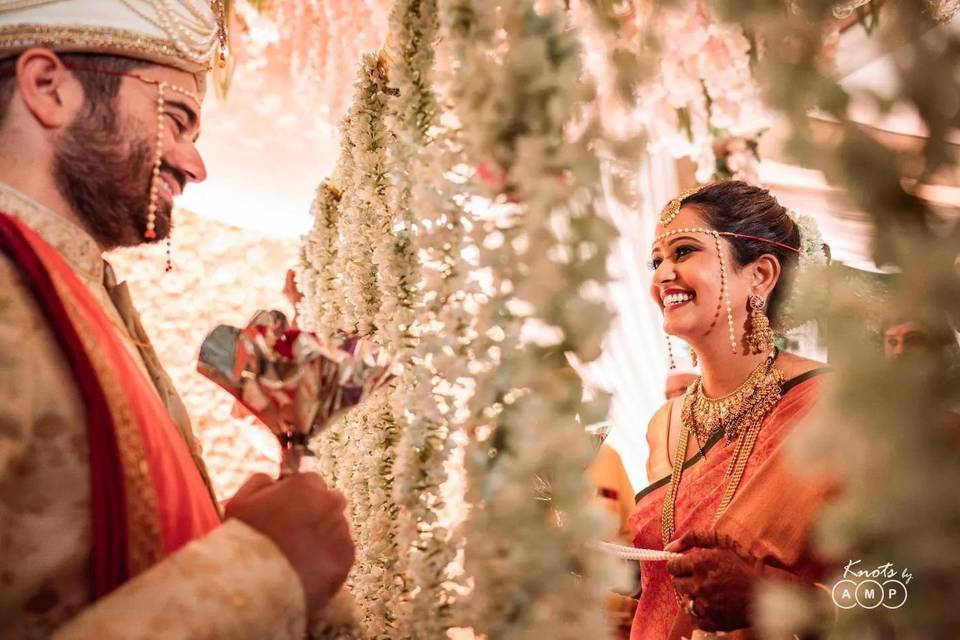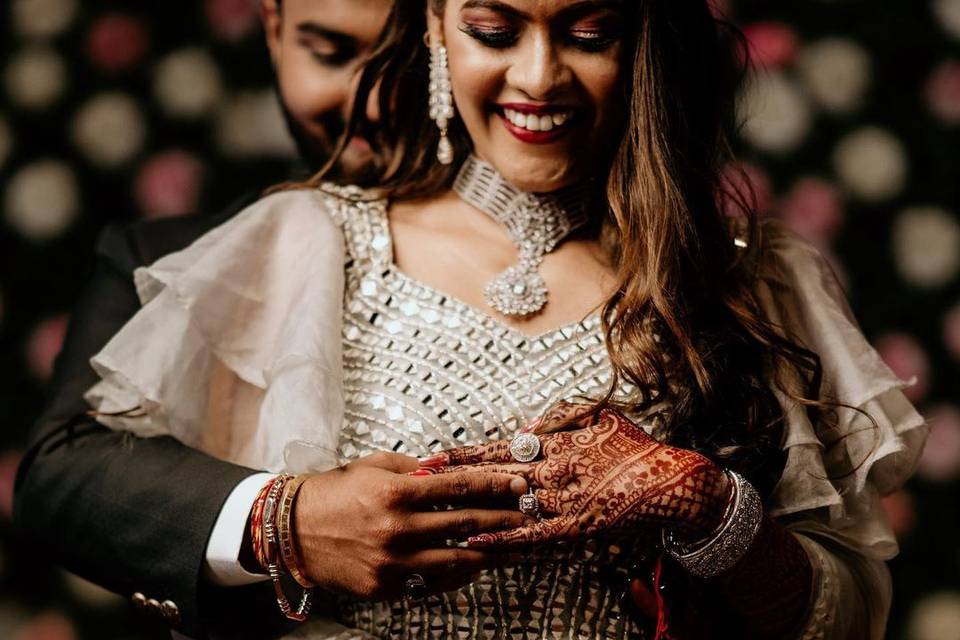Decoding Tamil Marriage: the Sacred Ceremonies & More
The Tamil marriage traditions are deeply embedded in their culture & here’s are the details that makes these weddings so unique. Read to know.
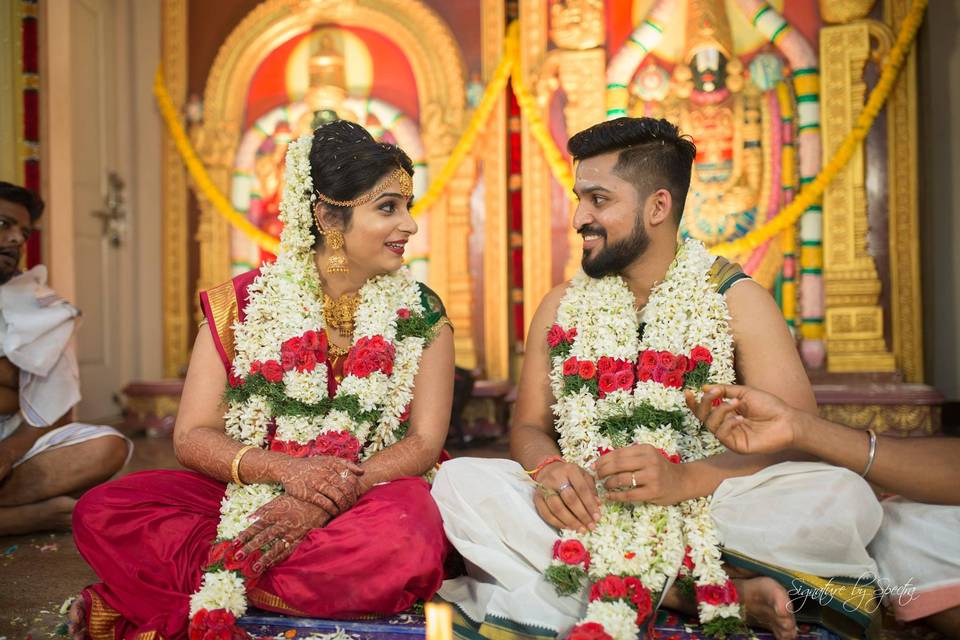
Wedding ceremonies are rituals built upon age-old beliefs and traditions and are an important part of any wedding celebration. A wedding is a joyous celebration of commitment and the coming together of two families. The Tamil culture is known for its simplicity and the rituals performed as part of the wedding ceremony stay true to their traditional form.
The Tamil marriage ceremonies celebrate different facets of a bride and groom’s entry into adulthood and different castes follow their own pre-wedding, wedding and post-wedding ceremonies.
Here’s what makes the rituals performed by each caste so unique.
Tamil marriage Pre-wedding ceremonies
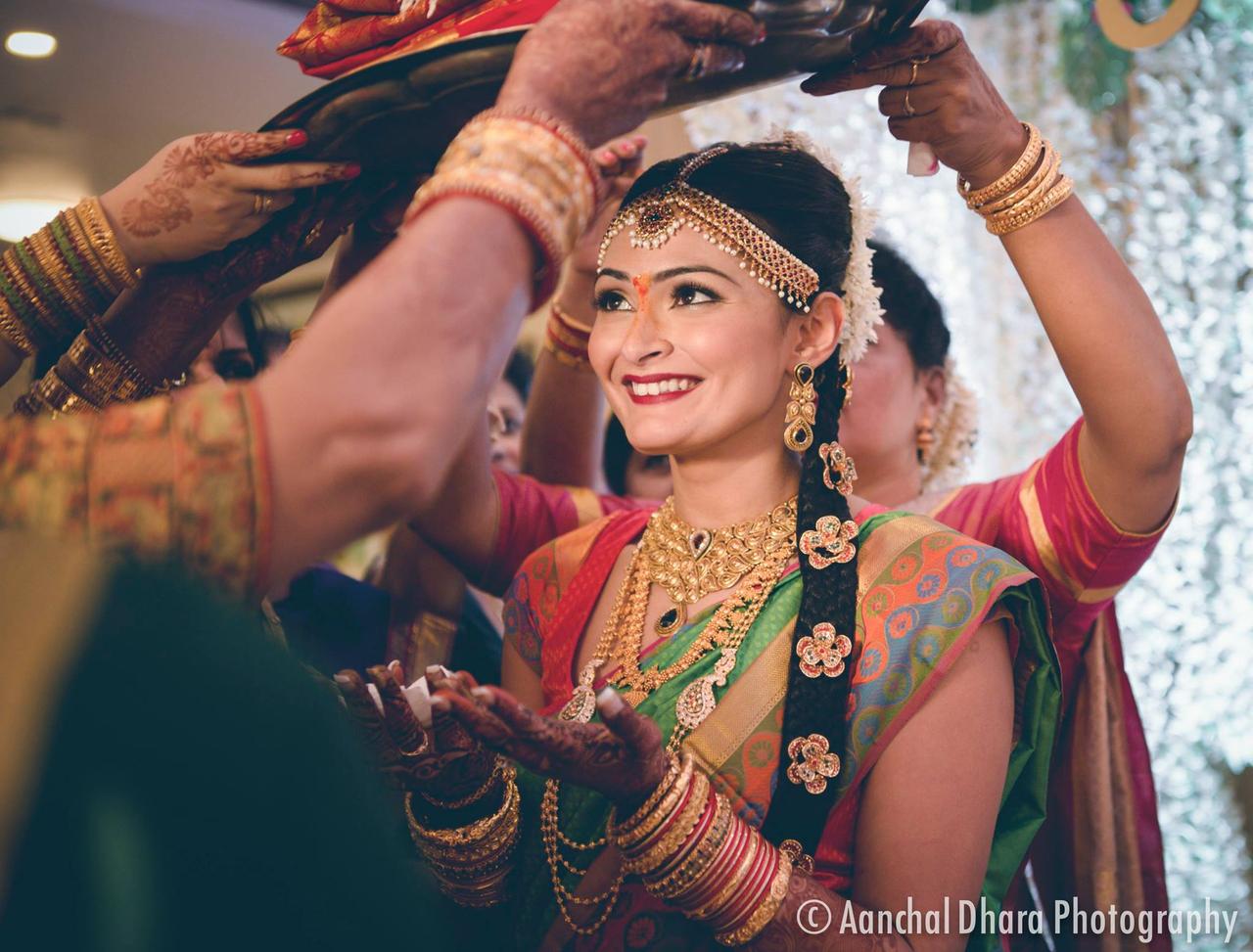
The pre-wedding rituals are a celebration of the love and harmony between the two families. The Tamil marriage ceremonies begin much ahead of the day of the actual wedding. These pre-wedding festivities and rituals commence when the two families fix the date for the wedding. Let’s take a look at the colourful Tamil marriage ceremonies that create a spiritual bond between the bride and groom:
Iyer
The Iyer wedding would typically be hosted over 4 days back in the days but the modern take on the ceremonies has come down to a 2-day celebration. Right before the 2-day ceremony, smaller ceremonies take place at the respective residences of the bride and teh groom. These include praying to the "Kula Devatas" (family deities), putting up the panda kaal which is a bamboo pole with banana leaves outside the house that marks the house in which a wedding is on. Mehndi has always been a part of the ceremonies too, but sangeet and so on have come into existence now for the millennials.
1. Nichayathartham: In Iyer Tamil marriage ceremonies, once the marriage is mutually agreed upon by both families, they decide on an auspicious day for the Nichayathartham (engagement ceremony). On this special occasion, a pooja is held to invoke the blessings of Lord Ganesha which is followed by a reading of the Langa Patrika that provides details on the day, date and time of the Muhurtham (wedding). This document is signed by both families as a seal of approval.
2. Sumangali Prarthanai: This ritual involves a prayer that invokes the blessings of the female ancestors who must have left for their heavenly abode before their husbands making them the 'sumangalis.' Married women who are invited for this ceremony are supposed to represent the ancestral 'sumangalis' and are worshipped and fed the traditional food as a sacred meal. Apart from this a 'kanya' is also worshipped and is a part of the feast. This sumangali prarthanai is done in the bride's home before the wedding so she can be a part of the rest of the ceremonies and in case of the groom it is done immediately after the wedding.
3. Pongi Podal: The bride and groom are invited to the homes of the extended families (aunts and uncles) for a feast that includes traditional foods like Pongal, Sambar and any other food they may want to eat. The food is prepared by the elders of the home and is given to the bride and groom as a blessing so they go on to have their own families.
4. Yatra Danaam: For this ceremony, the groom and his family visit the home of the bride where both families offer a prayer to Lord Ganesha and give Daana to the Brahmins and are said to ward off evil. A coconut is broken to mark the significance of this auspicious occasion.
5. Receiving the Groom: The groom and his party are received by the bride's family with coconuts, flowers and thamboola (betel leaves and areca nuts) with two conical decorated pieces called the 'paruppu thengai kutti' which is made of jaggery, lentil and coconut.
6. Vratham: Then there is the Vratham which involves the Vedic ritual of the groom taking permission from his father (who is the Guru in his life) to end his 'Brahmacharya Vratha" and begin his life as a "Grihastha." The bride and groom then perform certain 'sanskaras' and a sacred string of protection called Rakha or Kaapu is tied to the wrist of the bride and the groom while they chant Vedic mantras.
7. Planting seeds & sprinkling Peligai: This is then followed by the sprinkling of Paligai where it requires both the bride and the groom's families to plant seeds and then the seeds are sprinkled with a mix of milk and water by married women from both families with prayers for a long and happy married life for the couple and blessings for their descendants.
8. Januvasam: Finally, the Januvasam takes place where the groom is brought to the 'mantapam' in a grand procession accompanied bu 'nadaswaram.' The rituals done during the ‘nischyadaartham’ are repeated here and the bride’s brother presents clothes and jewellery to the groom and the groom’s sister does likewise to the bride. Both are then taken to a nearby temple to obtain blessings.
Vanniyar
1. Nischayathartham: The bride and the groom's families match their horoscopes. They meet and discuss the details about the marriage and an auspicious date is fixed to conduct the Nischayathartham or Parisam Poduthal function or the engagement. The grom's family visits the bride's family and presents a Thamboolam in the presence of elders. A large plate made of silver containing gifts like jewellery, money, flowers and Vethilaipak is offered to the bride. The groom's family can also carry betel, areca nut, flowers, fruits, saffron, sandalwood powder, coconut, turmeric along with a new sari and glass-beads threaded in a string.
To mark the end of this ceremony, betel leaves and nuts are presented to the guests who attended the ceremony, right after the feast.
2. Marriage pots: To signify a long and prosperous wedding life, the bride visits the groom’s home a day before the wedding accompanied by a woman of the pottery caste. Theirs bring with them, beautiful pots that are designed for the marriage.
3. Decorating the Marriage Dais: The marriage dais will be beautifully decked up - the handle of a plough or milk pot will be kept close. The Ammi kalu or the Mortar Pestle, a large mud pot with a light inside (Kuda Vilakku) and an ornamental lamp will also be placed. Many Vanniyars will use the Vanni tree branch as the first stick to support the constructed dais. They worship this tree for success and for forgiveness.
Chettiar
A Chettiar wedding is an elaborate line of celebrations with kaleidoscopic rituals that last up to 6 days. In a Nagarathar wedding, the couple has to take permission from the temple of the groom and as a sign of approval, the temple authorities send the garlands to the couple at the venue later.
1. Vaali Vanguthal: The groom's family meets the bride's family at a common meeting place. In the early days, the bride's family would give a silver bucket to the groom's family that will be filled with banana, betel leaves and nuts. Once the groom and his family approve of the bride, they take the bucket. However, in recent times, this is just a formality and the bride and groom's family exchange betel nuts and leaves as a token of acceptance.
The families then consult the astrologers to fix a pious muhurtham for the wedding.
2. Muhurtha Kaal Unrudhal: Once the wedding date is finalised by both families. The extended relatives arrive 4-5 days before the Tamil marriage. A bamboo stick with mango leaves is set up and pooja is performed by the Iyer along with the relatives of the bride and groom. The members of the family place Mangal and Kumkum in five areas of the cane. This ritual signifies that the marriage will happen in the home where this Puja is done.
3. Mappillai Azhaipu: The groom's family arrives at the bride's house a day before the actual muhurtham. However, they do not enter the bride's house but is welcomed by the bride's family members at the community hall or the temple where they stay the night.
4. Pen Edukki Kattuthal: For Nagarathar Chettiars, this is one of the most important pre-wedding Tamil marriage ceremonies because it is the first time the bride and groom meet each other. As the groom approaches the bride’s home, the bride is asked to come to the door to greet him.
Gounder
1. Ezudhingam: Before Tamil marriage ceremonies, the Arumikaarar is chosen. He is a respected male member of the community who will conduct the wedding proceedings for the newlyweds. A women member, Arumaikaari, is also chosen to perform all the rites of the wedding along with the Arumikaarar.
2. Kudimagan: The Navidhar (Barber) plays a significant role in the wedding. He assumes the role of inviting the guests for each ritual before the wedding and performs the Mangala Vaazhthu along with the Arumikaarar at the wedding. The Navithar also shaves the groom’s head before the wedding as is customary for the Gounder community Tamil marriage.
Tamil marriage Wedding ceremonies
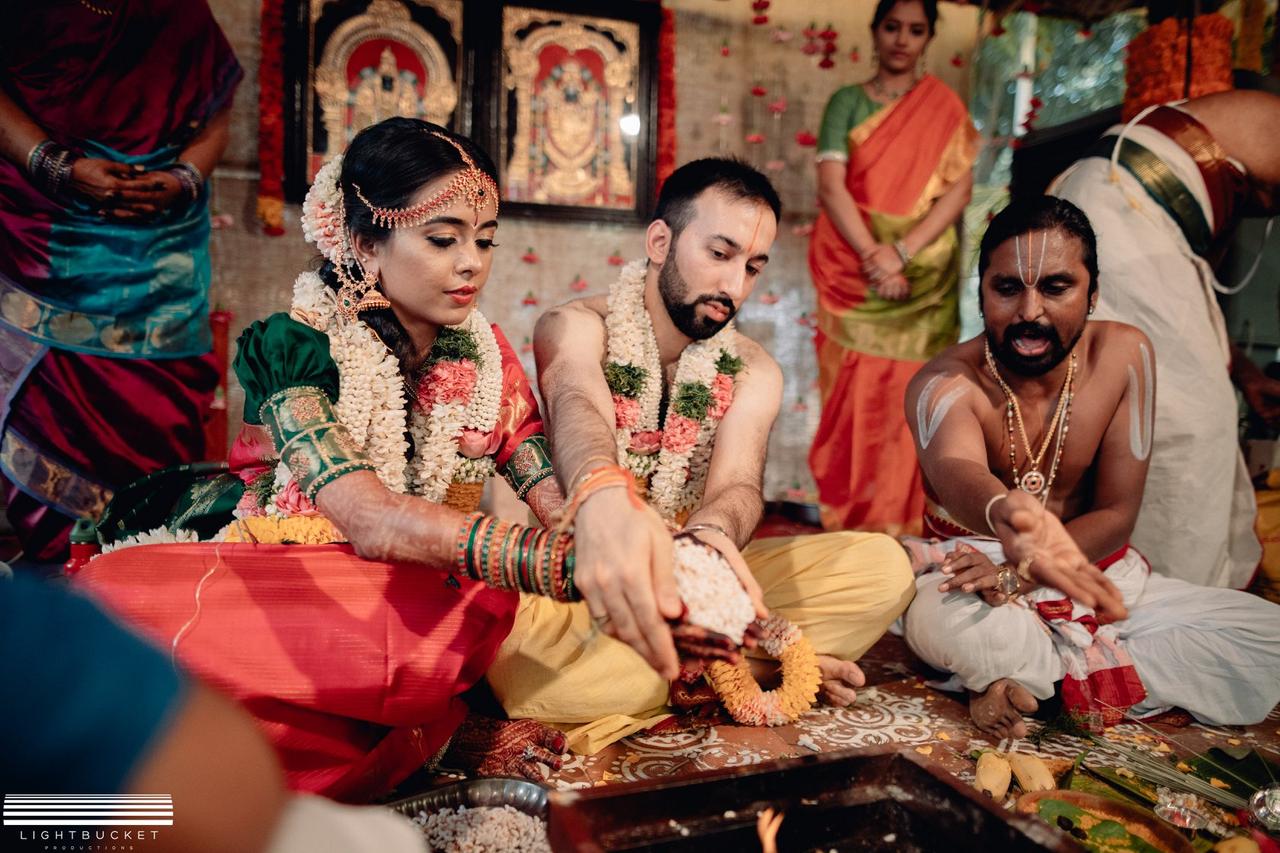
The wedding celebrations are a celebration of the unity and love between the bride and the groom. These time-honoured traditions are performed in accordance with the religious texts known as the Loukika Custom. However, the rituals can vary by caste as described below:
Iyer
1. Kasi Yatrai: As part of this ritual, the groom carries a bamboo fan, an umbrella and a walking stick and sets out to Varanasi to learn more about the religion. However, he is stopped by the bride’s father who offers his daughter’s hand in marriage. The groom returns to the Mandapam after accepting the bride's hand in marriage.
2. Vara Poojai: The bride's father washes the feet of the groom and the groom chants prayers invoking Lord Ganesha to bless the beginning of his wedding ceremonies.
3. Malai Mantral & Oonjal: After the garlands hat the florists are a professional at making, are exchanged at the Mandapam, the groom takes the bride’s hand and leads her to the Oonjal or swing. Whilst seated at the swing, the married women in the family wash the couple’s feet in milk and throw rice balls to ward off evil spirits. The bride and groom are then offered a drink with milk and banana pieces.
4. Pravaarams: The ‘Gothras’ of both the bride and the groom are announced loudly by the priest along with their lineage up to three generations (father-grandfather-great grandfather).
5. Kanya Daanam: The bride sits on her father’s lap and places her palm in his while holding a coconut. The father then places his daughter’s hand in the groom’s while the mother pours water on their hands. This waterfalls to the ground and is called ‘Dhaara’.
6. Dharai Vaarthu Kodukkal: When the water falls from the bride's hands like a dhaara, this ceremony is called ‘dhaarai vaarthu kodukkal’ in Tamil. The mantras chanted by the bride’s father symbolise the groom as a personification of Lord Vishnu. The ‘Gothra’ of the bride is changed to that of the groom.
7. Maanglya Dhaaranam: The groom gives the ‘koorai podavai’ – a traditional nine-yard saree to the bride that she is supposed to wear to begin her life as the missus. The groom’s sister and other ladies of his family take the bride away to help her drape the ‘koorai podavai’ for the ‘maanglya dhaaranam’. The bride’s father then, once again, washes the feet of the groom and gives him a mixture of curd, honey and ghee. The 'maangalya' or 'mangala sutra' is the twin pieces of gold that is given by the bride’s father and the groom and is placed on a yellow sacred string. This is tied around the bride’s neck in three knots -first tied by him and the other two knots are tied by his sister. This ceremony is performed amidst the chanting of mantras and a crescendo of 'nadaswaram', 'ketti melam', 'akshadhai' showers (turmeric smeared rice) and flower petals by the family members and friends to bless the couple.
8. ‘Sapta-padhi’: ‘Sapta-padhi’ or seven steps is vital for the completion of the marriage. The groom takes the right foot of the bride and makes her take seven steps with prayers for her happiness, well-being and prosperity. The bride and the groom circle the Agni and on reaching the 'ammi kal' (grinding stone) the groom takes the toe of the bride’s right leg and places it on the stone. When they return to sit in front of the fire, the bride’s brother puts two handfuls of puffed rice in her hands, which is then offered to the ‘Agni’ by the bride and groom with a small quantity of ghee. This entire ritual is repeated thrice.
Vanniyar
1. Tying the Pattam: Once the groom ties the thali around the bride’s neck, they swap places and their clothes are tied together. The maternal uncles then tie a Pattam around the couple’s foreheads. The Pattam is in the shape of a leaf for the bride and a Vaishnavati Nammam for the groom.
2. Ammi Midithai: This ritual involves stepping over a Mortar Pestle and looking up at the Arunthathi star. In the Vanniyar community, the bride and groom circle the milk pot and dais three times. This is followed by the groom placing the bride’s feet over the Ammi and placing a toe-ring on the bride’s second toe called the Metti.
3. Nalangu: This ceremony happens fro the bride and the groom separately. The bride and groom are made to seat on a wooden plank and five chosen women smear oil by using grass stems and apply a green gram paste. They will then do an aarti made of lime water mixed with turmeric to ward off the evils. Then they are both taken for a ceremonial bath.
4. Kanganam: The priest who commences and conducts the marriage ties a yellow thread that is known as the Kanganam around the wrists of the to-be-w. This is supposed to be a sacred thread and is then tied on the wrist of the bride right before the wedding ceremony commences.
5. Thali Ceremony: The marriage is marked complete when the groom ties the Thali around the bride's neck. Before tying the Tahli it is kept on a plate along with coconut, betel leaves and nuts. It makes a round of the venue where all the elders present bless the Thali and on a chosen muhurtham the groom ties it while the mantras are chanted, conch shells are blown and flutes are played. A Kamakshi Vilakku representing the goddess Kamatchi of Kanchipuram will be held by the sister of the groom to invoke the blessings of the goddess who is known as the bride of Lord Shiva. The elders present at the hall will bless the couple showering atchathai (rice coloured with turmeric).
6. Pattam: After the groom has tied the Thali to the bride, the couple swaps their seats and the ends of their wedding outfits are tied together. The maternal uncles of the couple will then tie the pattam in gold and silver on their foreheads. The bride's pattam will be in the shape of a papal tree lead and the groom's will be in the shape of Vaishnavati Namam
Chettiar
1. Thirupootuthal: The maternal uncle of the to-be-weds are the official facilitators of the wedding. They wear a mamakara pattu, which is a pink fluorescent silk towel that they wrap around their body. The maternal uncle of the bride then brings the bride to the groom, who sits in the manal. The groom then ties the Thali or Kaluthiru around the bride's neck. After the wedding, a gold thali replaces the thread thali for regular use.
2. Mappillai Azhaipu: This ceremony occurs the day before the wedding where the groom’s family arrives at the bride’s home. However, they do not enter the room but wait in the hall or temple to be welcomed by the bride’s family. This signifies the unity between the groom and the bride’s family.
3. Vaevu Irakkuthal: This ritual represents the wealth of the family in the form of grains and vegetables. The items are carried on a silver plate by the bride’s uncle with the help of the groom’s maternal uncle and received in the groom’s home.
4. Poo Manam Choridhal: The ceremony involves giving blessings to the bride and groom as they sit with folded legs. The elderly male relatives of the family dip their hands in a bowl full of petals and pick a few petals to place them on the lap and folded legs of the couple.
5. Manjal Neeru Aduthal: The cousins of the couples wash the feet of the newlyweds with Manjal Neer (pure water).
Gounder
1. Naal Virundhu: The marriage festivities begin with the Naal Virundhu. It is a small feast arranged for the close family members. The families celebrate the harmony and unity of the newlyweds.
2. Mangala Vaazthu: In the Gounder community, reciting the Mangala Vaazthu is an important part of the wedding ceremony. This song was written by the Poet Kambar and the lyrics describe the events of the wedding and compare it to that of the royal family.
The song sings the praise of the institution of marriage and blesses the newlyweds.
Tamil marriage Post-wedding ceremonies

The post-wedding Tamil marriage ceremonies are all about the families wishing the bride and groom a prosperous and happy life together. The bride is also welcomed to the groom’s home and embraced as a member of the family. Here are the main post-wedding Tamil marriage ceremonies for each caste:
Iyer
Another interesting ritual following the wedding is when the bride and the groom are asked to take a look at the two-star constellation of ‘Arundhati’ and ‘Vasishtha.’ In this special constellation, the two stars, ‘Arundhati’ and ‘Vasishtha’ move in tandem while revolving around each other, just like how a married couple should be. At the time of completion of chanting of mantras, the groom unties the ‘darbha’ rope tied around the bride. This is followed by blessings showered upon the newly-married couple by all the elders of both the families.
1. Grupravesha: This is when the bride arrives at the groom’s home for the first time. She is greeted at the entrance with an Aarthi that is performed by her mother-in-law. It is auspicious for the bride to enter the home with her right foot forward and knocks over a pot of rice as she does this. When the bride visits the groom's place for the first time or vice-versa the female relatives give them ‘paalum pazhamum’ or a mixture of milk with bananas. A ‘nalangu’ ritual may be held either at the wedding venue or at the groom’s residence, these are the fun games that act as an ice-breaker post-wedding.
2. Sambandhi Virandh: To celebrate the momentous occasion that marks the completion of the wedding festivities, the families of the bride and groom exchange gift such as gold, jewellery and clothes.
3. Reception: For a Tamil marriage in the Iyer community, reception is not mandatory but in recent years, many families choose to have one after the wedding. This is a fun occasion where friends and families are invited for an evening of dancing and celebrating the happy couple.
Vanniyar
1. Arundhati Parthal: The Vanniyar community believes that the wife of a sage is known for her piety and is said to be constellation in the sky. Once the wedding rituals are complete, the priest who performs the Tamil marriage ceremonies points to the sky where the star usually appears and explains its significance.
2. Mock ploughing ceremony: When the marriage rituals are complete, it is followed by a mock ploughing ceremony. The Kanganam that is tied to the wrist in the morning is removed. The groom carries a plough followed by the bride who brings a pot with Kanji with her. He will then mockingly plough the land and plant some seedlings.
And betel and leaf are offered to a small Pillayer made of cow dung to signify the chastity of the marriage. The bide offers the Kanji to her new husband.
Chettiar
1. Kumbuttu Kattikolluthal: After the wedding, the bride will receive blessings from the elders in the family while holding a doll of Lord Krishna. To bride falls at the feet of the elders to receive blessings. This act symbolises fertility for the future generation.
2. Mana Pen Solli Kolluthal: This is a tearful moment between the bride and her parents as she bids farewell to them. The bride receives the blessings of all the elder family members before she leaves for the groom’s home to start her new life with newer responsibilities.
3. Kattu Soaru Unnuthal: This is an age-old tradition where the groom and his family have to make a long journey for a day or more to their home with the groom. They packed food for this trip and it contained rice and they used to rest beside a pond or tank and have their food. Most Nagarathar marriages follow this tradition till date in some modified ways of course.
Gounder
1. Senjoru Aindhadai and Arugumanam Seidel: These rituals are performed after the Tamil marriage ceremonies aim is to remove any evil eye that may have been induced during the wedding.
2. Kalyana Virandhu: The Gounder marriage is followed by an extravagant vegetarian meal served on plantain leaves. The meal is a joyful celebration of the newlyweds.

Tamil marriage ceremonies hold deep significance and cultural value. Each ritual intends to foster harmony among the two families and strengthen the bond between the bride and groom. There are various communities within the Tamil culture have their own unique wedding rituals that help the Tamilians preserve their rich heritage and stay true to their roots.
With valuable inputs from Vidya Gopinathan, Communications Consultant.
Are you all set to plan your wedding? Get in touch with our wedding planners today!




